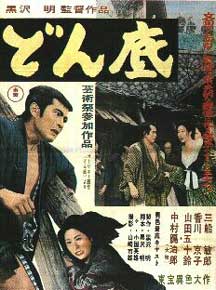 Set in a grubby run down house on the edge of a garbage dump, the cramped quarters in The Lower Depths (Donzoko, 1957) is populated by the refuse of society.
Set in a grubby run down house on the edge of a garbage dump, the cramped quarters in The Lower Depths (Donzoko, 1957) is populated by the refuse of society.
This refuse includes a fallen yakuza, Yoshisaburo (Koji Mitsui), who despite his intelligence has never really bounced back from a prison term & a habit of losing everything at gambling.
And there's a senile alcoholic actor, Danjiro (Kamtari Fujiwara), full of miseries over his inability to remember even his favorite passages from his past starring roles.
There's the angry old tinker Tomekichi (Eijiro Tono), with his dying wife (Eiko Miyoshi) who has never known what it is like to eat her fill.
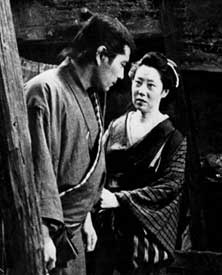 And there's the mad prostitute Osen (Akemi Negishi), lost in her own fantasies of once having been deeply loved. And there's the mad prostitute Osen (Akemi Negishi), lost in her own fantasies of once having been deeply loved.
So too there's the street-vendor Otaki (Nijiko Kiyokawa) who likes to think of her cheap candies as medicine.
And an ex-vassal (Minoru Chiaki) who has long ago sold his swords & has fallen lower even than any ronin.
Not quite the hero of the piece is the gruff thief Sutekichi (Toshiro Mifune) who wants to do good, criminal though he may be, but what good can anyone do in a world of grime & destitution. All these & others crowded into the shared space of a ruinous hovel.
Plus nearby is the greedy, heartless landlord Rokubei (Ganjiro Nakamura); his cuckholding wife Osugi (Isuzu Yamada) who tries to convince Sutekichi to kill her husband; & her sister, innocent Okayo (Kyoko Kagawa), whom Osugi beats & abuses out of jealousy that Sutekichi loves her.
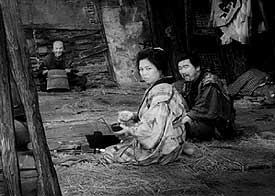 Into this pathetic group comes a wanderng pilgrim played by Bokuzen Hidari, usually a comic actor with an inherently amusing face, but here given a rare & transcendently serious role that has got to have been the best in a long career of many fine roles. Into this pathetic group comes a wanderng pilgrim played by Bokuzen Hidari, usually a comic actor with an inherently amusing face, but here given a rare & transcendently serious role that has got to have been the best in a long career of many fine roles.
His character Kahei becomes the heart of the film as he interacts with & assesses & tries to uplift each of these forlorn souls, telling each sweet lies that give them hope in a hopeless world.
There's no story to speak of, it's strictly a film of character, & such characters they are! The Lower Depths embodies some of the best acting ever caught on film. Everyone recognizes Kurosawa's Seven Samurai & Ikiru as classics, but this comparatively underestimated film deserves to be considered in the same breath.
Although inspired by Maxim Gorky's famous play, "based on" would be an exaggeration. Kurosawa has transformed Gorky's character array & environment into something purely Japanese.
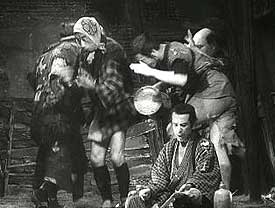 The minimalist environment of the film is the building itself, & the characters are never shown far from its interior. The minimalist environment of the film is the building itself, & the characters are never shown far from its interior.
This set embodies a gloomy work of art design which is veritably an additional character in the story. The camera occasionally lingers on some dispiritingly marred board or doorway, & the viewer's eye is drawn painfully into the composition.
I adore The Lower Depths & believe it has one of the most astonishing climaxes of any film ever made, though in terms of plot resolution or action it is not a climax in any normative sense.
This climax merely captures a shattered moment of happiness among people with no reason to be glad, constructed around authentic Edo period peasant gion festival music, which Kurosawa made the cast listen to on ethnographic recordings for weeks before filming the majority of the cast concocting their beautiful rough-hewn piece of self-satirizing music.
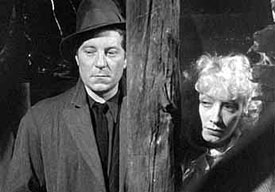 Maxim Gorki's classic novel had earlier gotten stunning cinematoraphy & a soundtrack that is sometimes overbaked but mainly appealing, in Jean Renoir's The Lower Depths (Les Bas-fonds, 1936). At the center of the tale we have the great Jean Gabin as Pepel the thief.
Maxim Gorki's classic novel had earlier gotten stunning cinematoraphy & a soundtrack that is sometimes overbaked but mainly appealing, in Jean Renoir's The Lower Depths (Les Bas-fonds, 1936). At the center of the tale we have the great Jean Gabin as Pepel the thief.
The character array is fabulous thanks to the root material by Gorki, an incredible feat of condensation into a script, & the tremendous acting talent who bring it all alive.
The setting of the flophouse is like a shelter in Limbo where everyone awaits some future fate never realizing they've already come to their penultimate estate, with only death apt to provide another act.
Vassilissa (Suzy Prim), a young fence, is married to the old slumlord (Vladimir Sokoloff) who has in his day had a few connections, but has gotten senile. Quite naturally she is drawn to the vastly more vital Pepel. There's Vassilissa's naive sweet sister (Junie Astor), who has yet to comprehend the abject horror attached to mere survival.
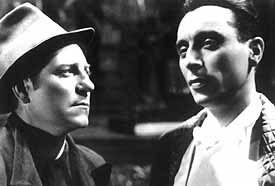 There's the tough cool blonde streetwalker Nastia (Janie Holt) who clings to a romantic ideal; the actor-accordionist-drunkard (Robert Le Vigan); and the Baron (Louis Jouvet), a ghostly, odd young gambler with no luck. There's the tough cool blonde streetwalker Nastia (Janie Holt) who clings to a romantic ideal; the actor-accordionist-drunkard (Robert Le Vigan); and the Baron (Louis Jouvet), a ghostly, odd young gambler with no luck.
Among these characters, Pepel & the Baron are signal. Pepel breaks into a wealthy house finding less than he expected, but does at least find a handgun.
When the bankrupt gambler Baron Felix arrives home, he cannot find his gun with which to commit suicide. The thief steps out & an unexpected friendship is struck.
They stay up all night at cards & conversation. At dawn the Baron lets the thief take whatever he likes, since debtors will take it all anyway.
The actor, the shoemaker, the harlot who believes in love, the slum lord & his cuckolding wife, the thief, Natasha the only innocent, the Baron, with others, are simply stunning characters played each with genius. The desparately poor are shown in contrast to the declining Decadent class. No one is more than a footstep from despair. Jean Renoir's film is a superb & intelligent artistic achievement.
copyright © by Paghat the Ratgirl
|


 And there's the mad prostitute Osen (Akemi Negishi), lost in her own fantasies of once having been deeply loved.
And there's the mad prostitute Osen (Akemi Negishi), lost in her own fantasies of once having been deeply loved. Into this pathetic group comes a wanderng pilgrim played by Bokuzen Hidari, usually a comic actor with an inherently amusing face, but here given a rare & transcendently serious role that has got to have been the best in a long career of many fine roles.
Into this pathetic group comes a wanderng pilgrim played by Bokuzen Hidari, usually a comic actor with an inherently amusing face, but here given a rare & transcendently serious role that has got to have been the best in a long career of many fine roles. The minimalist environment of the film is the building itself, & the characters are never shown far from its interior.
The minimalist environment of the film is the building itself, & the characters are never shown far from its interior.
 There's the tough cool blonde streetwalker Nastia (Janie Holt) who clings to a romantic ideal; the actor-accordionist-drunkard (Robert Le Vigan); and the Baron (Louis Jouvet), a ghostly, odd young gambler with no luck.
There's the tough cool blonde streetwalker Nastia (Janie Holt) who clings to a romantic ideal; the actor-accordionist-drunkard (Robert Le Vigan); and the Baron (Louis Jouvet), a ghostly, odd young gambler with no luck.